 Audio for slide 2 (mp3)
Audio for slide 2 (mp3)
Experienced floor layers know that the long-term quality of a finished project always starts with the subfloor. Even though the client often doesn't see this stage of the job, it's the part that most often causes problems in the finish or performance of the floor covering.
 Audio for slide 3 (mp3)
Audio for slide 3 (mp3)
In this unit, we'll cover the processes of preparing the subfloor and applying various coatings and toppings to the surface. We'll use the term coatings to refer to primers and liquid moisture membranes, and toppings to describe all patching, levelling and smoothing compounds.
 Audio for slide 4 (mp3)
Audio for slide 4 (mp3)
We'll also use the term substrate to refer to the subfloor surface. In the unit Inspecting and testing subfloors we gave 'substrate' the precise definition from Australian Standard 1884-2012 (resilient floor coverings) to describe the layer immediately under the floor covering. However, this more general definition includes any layer below another layer that's placed on top.
 Audio for slide 5 (mp3)
Audio for slide 5 (mp3)
Primers, moisture barriers and damp proof membranes will also be discussed in this unit. Note that all of these processes involve 'building up' from the surface of the subfloor. The process of 'going down' - or removing layers - is covered in detail in the unit: Concrete grinding.
 Audio for slide 8 (mp3)
Audio for slide 8 (mp3)
One of the most important points to remember when you're preparing a subfloor surface for a coating or topping is that the strength of the bond can only ever be as good as the surface you're bonding to. This means that anything on the surface that might reduce the bonding strength will need to be removed.
 Audio for slide 9 (mp3)
Audio for slide 9 (mp3)
It also means that the moisture content of the subfloor must be at an acceptable level or be controlled with the use of a moisture barrier. In addition, concrete floors need to have reached a suitable pH level, to avoid the problem of an alkaline reaction with the adhesive and floor covering.
 Audio for slide 10 (mp3)
Audio for slide 10 (mp3)
In this section, we'll discuss the preparations you'll need to carry out before installing a coating or topping. We'll also look at the health and safety issues involved in preparing subfloors, applying coatings, mixing compounds and installing the underlayment.
 Audio for slide 12 (mp3)
Audio for slide 12 (mp3)
Of all the problems that can occur in a finished floor, the ones that stem from high moisture or pH levels are likely to give you the most trouble. That's why you need to be very thorough in your moisture and pH testing before you start any preparation work.
 Audio for slide 13 (mp3)
Audio for slide 13 (mp3)
Moisture levels Set out below are the relative humidity (RH) and moisture content (MC) levels permitted under the Australian Standards for textile floor coverings (AS 2455) and resilient coverings (AS 1884). Note that these figures are general specifications - manufacturers of flooring products may have different specifications listed in their installation guidelines. There may also be particular regions in Australia where these limits are not appropriate, such as in North Queensland where atmospheric humidity often remains high for long periods of time.
 Audio for slide 14 (mp3)
Audio for slide 14 (mp3)
For each subfloor, three tests need to be carried out in the first 100 m2 plus one extra test for every additional 100 m2. Tests may also need to be done in other locations, depending on the structure of the floor.
 Audio for slide 15 (mp3)
Audio for slide 15 (mp3)
Concrete subfloors For the surface-mounted insulated hood test, the maximum relative humidity allowed is 70% For the in-situ probe test, the maximum RH is 75%
 Audio for slide 16 (mp3)
Audio for slide 16 (mp3)
If it turns out that the RH level is not acceptable for the coatings or toppings you're planning to use, you will have to make a choice - either: wait until the concrete dries down to an acceptable level, or apply a moisture barrier to the surface.
 Audio for slide 17 (mp3)
Audio for slide 17 (mp3)
Timber subfloors In timber subfloors, the allowable moisture content (MC) range is 10-14% If the moisture content is above 14%, it could mean there's a subfloor ventilation problem or that the floor has been flooded due to a broken water pipe or some other plumbing problem. In these cases, you'll need to address those issues first and then wait for the floor to dry.
 Audio for slide 18 (mp3)
Audio for slide 18 (mp3)
pH levels The latest Australian Standard for resilient flooring installation (AS 1884-2012) says that a pH test must be carried out on all concrete subfloors as part of the pre-installation assessment. The pH level should be within the 9-10 range. Again, three tests need to be carried out in the first 100 m2, plus one extra test for every additional 100 m2.
 Audio for slide 19 (mp3)
Audio for slide 19 (mp3)
Note that freshly poured concrete always has high alkalinity (often with a pH of 12-13), because this is a by-product of the chemical reaction occurring between cement and water. So you don't need to be concerned about high pH levels while the concrete is still drying. However, if the concrete has reached equilibrium moisture content (EMC) and the pH is still too high, you'll need to take some action. The most common treatment is an acid wash. We'll talk more about this in the next lesson.
 Audio for slide 21 (mp3)
Audio for slide 21 (mp3)
Once you're satisfied that the moisture and pH levels are within the allowable range, it's time to prepare the concrete surface. This involves removing anything from the surface that might reduce the bonding strength or performance of the layers you're going to put on top.
 Audio for slide 22 (mp3)
Audio for slide 22 (mp3)
The sorts of things that have to be removed include oil, grease, asphalt, curing compounds, gypsum, dust and any other contaminants that could affect the new coatings or toppings. In addition to these substances on top of the surface, concrete subfloors sometimes have a weak or powdery surface layer due to spalling or laitance. See Inspecting and testing subfloors for more details on these conditions.
 Audio for slide 23 (mp3)
Audio for slide 23 (mp3)
There are various ways of removing contaminants and weak surface material. The method you use will depend on how serious the problem is and what the substances are. Set out below are the main methods.
 Audio for slide 24 (mp3)
Audio for slide 24 (mp3)
Abrasion The best way to achieve a clean bare concrete substrate is through some form of physical abrasion. The simplest method of abrasion is to simply scrape off surface blobs by hand with a floor scraper.
 Audio for slide 25 (mp3)
Audio for slide 25 (mp3)
More serious contaminants are removed by grinding away the affected layers of concrete with a machine. Depending on the amount of material that needs to be removed, you might use a grinder, shot blaster or scarifier. See the learning activity below for a link to several video clips that demonstrate these techniques. They are also explained in more detail in the unit: Concrete grinding.
 Audio for slide 26 (mp3)
Audio for slide 26 (mp3)
Acid washing For certain surface contaminants, some people like to wash the concrete with acid. However, this should only be used as a last resort, because most levelling compound manufacturers will not warrant their products unless the concrete surface has been mechanically ground. If you do decide to acid wash the surface, be careful to keep the solution within the confines of the slab and to completely remove any residue when you finish. Muriatic acid is generally used, which is a commercial grade of hydrochloric acid.
 Audio for slide 27 (mp3)
Audio for slide 27 (mp3)
To prepare the solution, mix 1 part muriatic acid to 10 parts water. Apply the solution with a watering can and use a stiff-bristled broom to spread it around the floor. Once the reaction has taken place, wash it off and make sure that it is completely neutralised before leaving the floor to dry. Note that acid washes are not effective in removing grease and oil. The same applies to solvent washes, which have a tendency to drive the contaminants further into the concrete pores.
 Audio for slide 28 (mp3)
Audio for slide 28 (mp3)
Degreaser and detergent Grease and oil can often be removed by scrubbing with a degreaser or detergent if the contaminants haven't penetrated too far below the concrete surface. Once you've finished, wash the concrete clean with water. Then allow the surface to dry and mechanically grind it down to clean concrete before starting the topping process.
 Audio for slide 29 (mp3)
Audio for slide 29 (mp3)
Dealing with 'cutback adhesive' Cutback is a black asphalt-based adhesive that was once used to install vinyl tiles. It often contains asbestos fibres. If the cutback is still firmly bonded to the floor, it's often easiest to leave it in place and only remove the thick accumulations and brittle or loose material. This is done by wet scraping and mopping the floor to avoid the creation of dust.
 Audio for slide 30 (mp3)
Audio for slide 30 (mp3)
Always remember that you need to be very careful to minimise the amount of dust produced, and to wear protective clothing that's suitable for the job. You must also follow proper disposal methods for asbestos based products. For more information on this topic, see the Queensland Government publication: Asbestos - A guide for minor renovation. There is also more information on how to identify and remove old asbestos-based vinyl and lino flooring in the unit: Resilient floor coverings.
 Audio for slide 32 (mp3)
Audio for slide 32 (mp3)
Timber surfaces include plywood and particleboard sheeting and solid tongue-and-groove boards. Solvents and strippers don't work well on timber floors, so you'll need to remove contaminants by sanding down to bare wood.
 Audio for slide 33 (mp3)
Audio for slide 33 (mp3)
Drum sanders are best on floors that need a lot of material removed. Belt sanders provide a finer finish, but get clogged up more easily, so they are most effective when the surface only needs to be lightly sanded. Orbital 'edgers' are used around skirting boards and corners.
 Audio for slide 34 (mp3)
Audio for slide 34 (mp3)
Once the sanding is completed, vacuum up all dust with an industrial vacuum cleaner. Also check that all boards or sheets are well fixed and there are no squeaks or movement underfoot. Re-nail or screw any loose boards or panels. Cement-based toppings should not be used on a particleboard substrate unless the manufacturer recommends it. This is because the particleboard is less tolerant of the high levels of moisture in the fresh underlayment than plywood or solid hardwood flooring.
 Audio for slide 35 (mp3)
Audio for slide 35 (mp3)
Where cement-based toppings are used on wooden subfloors, a diamond metal mesh should be put down first. Installers often use 12 mm 'tilers lath', which provides a strong support structure for the underlayment to bond to.
 Audio for slide 37 (mp3)
Audio for slide 37 (mp3)
The tools and equipment needed to prepare the subfloor and install an underlayment include ordinary hand tools as well as some more specialised tools. Below are some lists of the main tools used, grouped according to the stage they relate to during the overall installation process. Note that not all of these tools are used in every job - some of them apply only to concrete or timber floors.
 Audio for slide 38 (mp3)
Audio for slide 38 (mp3)
Preparing subfloors
| Broom and handbroom - for sweeping up particles and rubbish. |  |
| Straight edge - for checking planeness and smoothness. |  |
| Tape measure - for measuring dimensions and deviations in the floor. |  |
| Industrial vacuum cleaner - for vacuuming up dust and small particles. |  |
| Floor scraper - for removing dags, blobs of cornice plaster, etc. |  |
| Concrete grinder, scarifier, shot blaster, hand-held angle grinder - for removing ridges and contaminants by taking off the subfloor surface. |  |
| Drum sander, belt sander, orbital sander - for removing high spots, contaminants and surface coatings in a timber floor by sanding down to bare timber. |  |
 Audio for slide 39 (mp3)
Audio for slide 39 (mp3)
Installing a liquid moisture membrane
| Paint brush and roller - for applying the liquid moisture membrane. |  |
| Backpack sprayer - alternative method of applying the membrane. |  |
 Audio for slide 40 (mp3)
Audio for slide 40 (mp3)
Applying a patching compound
| Trowel and putty knife - for applying cement-based patching compounds. |  |
| Bucket - for mixing the patching compound with water. |  |
 Audio for slide 41 (mp3)
Audio for slide 41 (mp3)
Applying a levelling compound
| Water gauging bucket - for measuring out the exact amount of water required per bag of topping compound. |  |
| Mixing paddle and heavy-duty drill - for mechanically mixing the topping. |  |
| Mixing and cleaning buckets - for holding the topping compound and water while they are being mixed and for cleaning up. |  |
| Trowels - for spreading the underlayment in a kneeling position. |  |
| Thickness spreader - for spreading the underlayment in a standing position. |  |
| Smoother - for achieving a feather edge and touching up the underlayment. |  |
| Spiked roller - for 'de-aerating' (removing air bubbles) from the underlayment. |  |
| Spiked shoes - for wearing while using the spiked roller. |  |
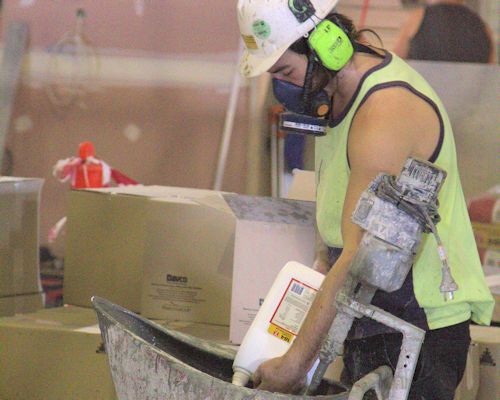 Audio for slide 43 (mp3)
Audio for slide 43 (mp3)
There are a few health and safety issues you'll need to be mindful of when you're preparing a subfloor and applying coatings and toppings. The main ones relate to manual handling, dust, fumes and skin contact.
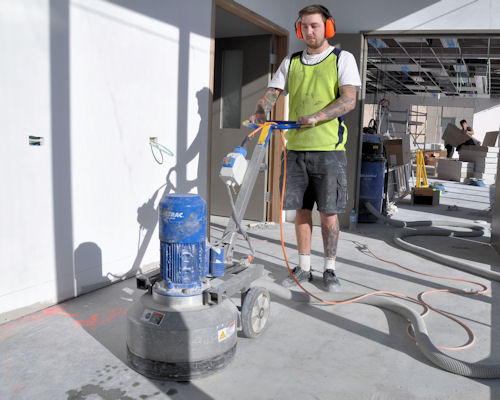 Audio for slide 44 (mp3)
Audio for slide 44 (mp3)
Manual handling Grinding and sanding subfloors can be hard work. Walk-behind machines are large and heavy, and often awkward to get on and off a vehicle. If you don't have any mechanical lifting aids, you'll probably need an offsider to help you get the machine from your workshop to the jobsite and into position.
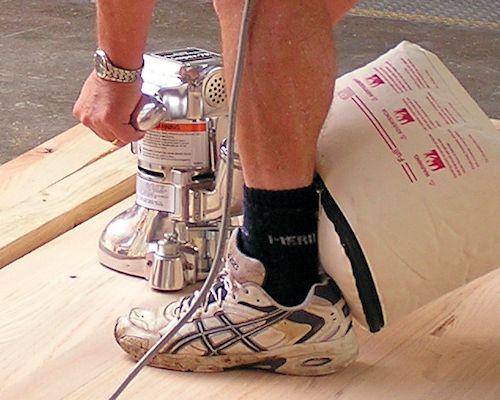 Audio for slide 45 (mp3)
Audio for slide 45 (mp3)
Hand-held sanders and grinders also need to be handled carefully. When you're working on your knees or in a crouching position, you have to be constantly aware of your posture and balance, the position of your hands and feet, and the location of the power lead.
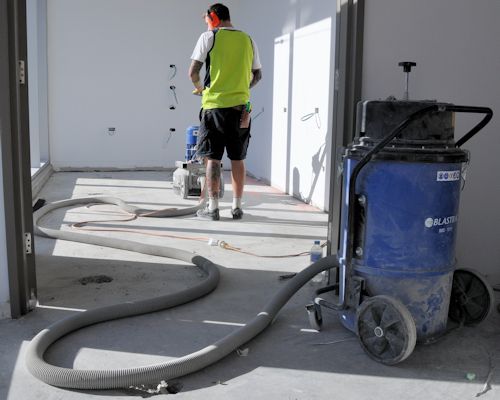 Audio for slide 46 (mp3)
Audio for slide 46 (mp3)
For more details on the safe work procedures you should follow when using these sorts of power tools, go to the unit: Concrete grinding. For general information on good manual handling practices and personal protective equipment, see: Safety at work.
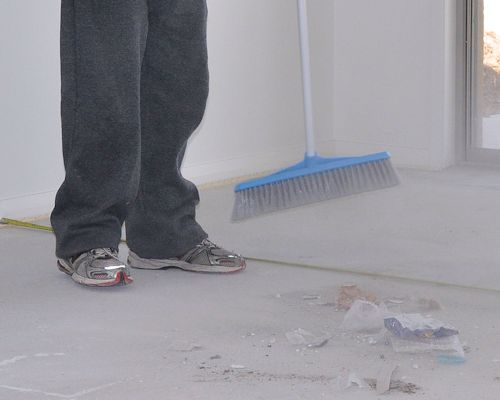 Audio for slide 47 (mp3)
Audio for slide 47 (mp3)
Dust Airborne dust is a big problem for flooring installers. Concrete and cement dust contains silica particles which can cause scarring of the lungs if you're regularly exposed to it. Timber dust can trigger allergic reactions in some people, and over time may cause nasal or lung cancer.
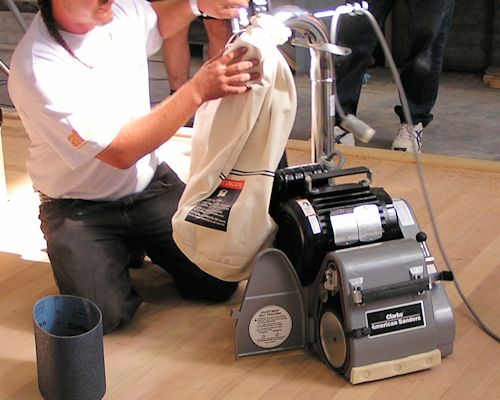 Audio for slide 48 (mp3)
Audio for slide 48 (mp3)
The best way to reduce the amount of dust floating in the air is to collect as much as possible while it's being generated. Hand-held sanders and grinders should have dust bags fitted. Walk-behind machines generally have vacuum ports that allow you to connect an external industrial vacuum cleaner, or alternatively have fitted bags.
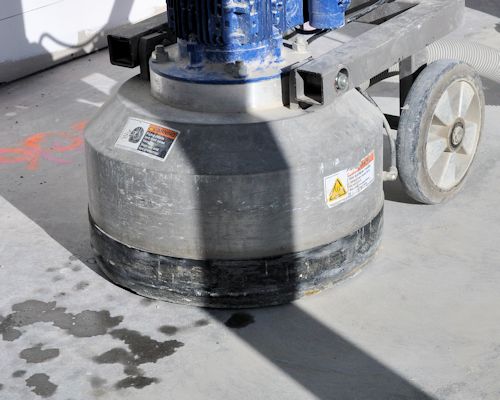 Audio for slide 49 (mp3)
Audio for slide 49 (mp3)
Another method of reducing airborne dust is to wet it down. Walk-behind grinders and scarifiers often have hose attachments that allow water to be sprayed directly onto the concrete while it's being worked. If you don't have a mist sprayer, you can sprinkle wet sand on the floor before you start grinding.
 Audio for slide 50 (mp3)
Audio for slide 50 (mp3)
Sweeping the floor surface also causes dust to cloud up and float in the air. One solution is to use an industrial vacuum cleaner wherever possible. If you must use a broom, spray a light mist over the dust first.
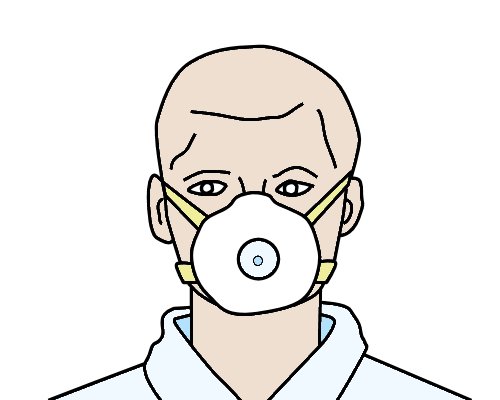 Audio for slide 51 (mp3)
Audio for slide 51 (mp3)
Finally, if you're generating dust or working in a dusty area, make sure you wear a mask. This includes when you're putting a levelling compound into a mixing bucket. The mask should be rated P2. Don't use a domestic 'nuisance dust' mask, because it's not designed for industrial use.
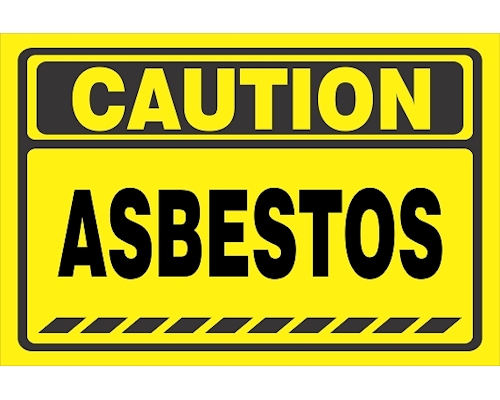 Audio for slide 52 (mp3)
Audio for slide 52 (mp3)
Note that a dust mask alone is not sufficient protection if you come across old flooring products that contain asbestos. In these instances, you need to notify the person in charge of the site and talk about how to handle it. There are laws in place that control the removal and disposal of old asbestos-based building products. For more information on dealing with asbestos, see the Code of Practice produced by Safe Work Australia called: 'How to safely remove asbestos'.
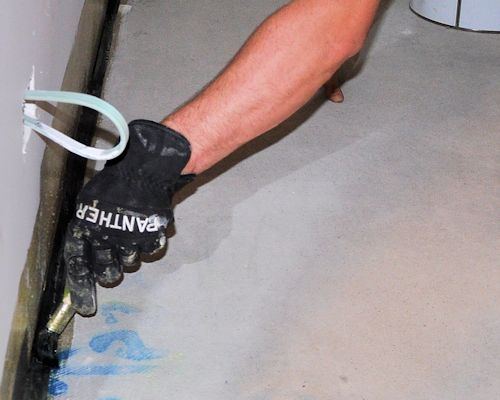 Audio for slide 53 (mp3)
Audio for slide 53 (mp3)
Fumes Some products give off fumes, especially if they're based on acids, solvents or epoxy resins. These fumes can cause long-term health problems if you regularly breathe them in. Sometimes they can make you feel very sick in a matter of minutes if you're working in an area with poor ventilation. Signs of being affected include light headedness and breaking out in a cold sweat.
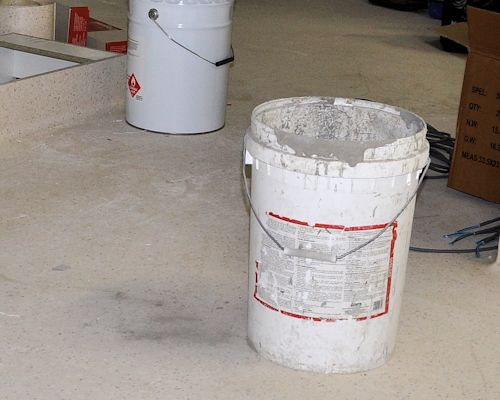 Audio for slide 54 (mp3)
Audio for slide 54 (mp3)
Always read the safety directions that come with hazardous products - you'll find them printed on the side of the container or packaging they're supplied in. In particular, pay attention to the ventilation requirements.
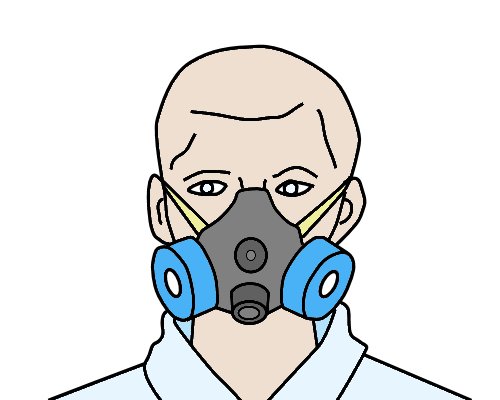 Audio for slide 55 (mp3)
Audio for slide 55 (mp3)
You may have to use a fan to blow the fumes away and wear a cartridge-type respirator while you're working. It's also a good idea to take regular breaks, say every 10 to 15 minutes, and go outside to get some fresh air. The Material Safety Data Sheet (MSDS) for the product will have full details on how to use and store the product safely, and there will be a section on what personal protective equipment you should wear. Some products come with an MSDS in the box or packaging. Your company should also have MSDSs for all hazardous products on file.
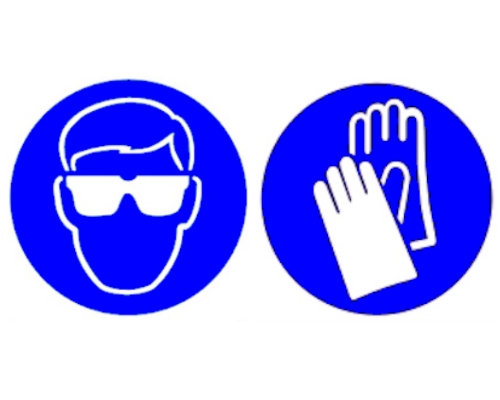 Audio for slide 56 (mp3)
Audio for slide 56 (mp3)
Skin contact
There are lots of products that come with the warning: 'Avoid contact with skin and eyes'. These include products that contain cement powder, acid, solvents and epoxy resin. Some of them may burn your skin or cause dermatitis; others have toxic chemicals that can be absorbed through your skin. In these cases, you should wear gloves while you're mixing and using the products. You may also need to wear safety glasses if there is a chance that the product might splash into your eyes.
 Audio for slide 59 (mp3)
Audio for slide 59 (mp3)
Moisture barriers are normally used in wet areas of buildings. In residential homes these are generally limited to bathrooms and laundries. But in commercial and public buildings they can include industrial kitchens, and particular areas of hospitals and aged care facilities.
 Audio for slide 60 (mp3)
Audio for slide 60 (mp3)
In addition to their use in wet areas, moisture barriers can also be applied to concrete subfloors to stop moisture from rising up through the slab and contacting the underside of the floor coverings. In this section, we'll discuss the various sources of moisture and the different methods of transmission. We'll also describe some of the processes used by flooring installers to apply liquid barriers and suppressants.
 Audio for slide 62 (mp3)
Audio for slide 62 (mp3)
We've already talked about the maximum permissible moisture and pH levels in concrete subfloors, as specified under the Australian Standards. But before you can decide on the best course of action to deal with moisture and pH problems, you need to know where the water is coming from. The most obvious source of moisture is the excess water that's put into the concrete mix to make it flow easily into the formwork and finish with a trowel.
 Audio for slide 63 (mp3)
Audio for slide 63 (mp3)
However, water can also enter the slab from external sources, such as the surrounding soil or rainwater runoff, particularly if there is no membrane - or vapour barrier, as it's often called - underneath the slab to protect it. When this happens, the moisture can travel through the cracks and pores in the concrete and make its way up to the underside of the floor covering. Because it happens out of sight, the moisture can cause a lot of damage to the flooring adhesive and floor covering before it becomes noticeable on the surface.
 Audio for slide 64 (mp3)
Audio for slide 64 (mp3)
The most important point to remember is that moisture likes to be in 'equilibrium', or balance, with its surrounding environment. So it tends to move from areas of low temperature and high humidity to areas of high temperature and low humidity until that balance is restored. Below are the main factors that affect the movement of moisture in concrete. Once we've looked at these mechanisms, we'll discuss the effect they can have on pH levels.
 Audio for slide 65 (mp3)
Audio for slide 65 (mp3)
Construction moisture 'Green' (or fresh) concrete always starts off with a very high moisture content. In reality, only about one third of the water in wet concrete is needed for the hydration process. The remainder is there to make it more workable. Before the concrete can reach EMC (equilibrium moisture content) with the surrounding atmosphere inside the building, the excess water has to evaporate from the surface.
 Audio for slide 66 (mp3)
Audio for slide 66 (mp3)
Concreters often use the rule of thumb that concrete dries at a rate of about 1 mm per day. This means that a 100 mm thick slab will take about 100 days to dry. But the rule only applies if there is no curing compound on the surface or any other covering that might slow down the drying process - so it can often take much longer.
 Audio for slide 67 (mp3)
Audio for slide 67 (mp3)
Capillary action Capillaries are tiny spaces that allow a liquid to flow through. Capillary action occurs as a result of the 'attractive force' between the molecules of a liquid and the 'adhesive force' of the very small spaces. This allows the liquid to flow against the pull of gravity. You can see it happen when blotting paper absorbs ink. It's also the force that allows plants to draw moisture up from the roots to the leaves, and a kerosene lamp to draw fuel through the wick.
 Audio for slide 68 (mp3)
Audio for slide 68 (mp3)
The same thing happens with concrete capillaries. If there is no vapour barrier underneath the slab and the soil is wetter than the concrete, moisture will be drawn up through the tiny cavities and evaporate from the surface. This is a common problem with slabs that are more than 50 years old, because it was not standard building practice in those days to install vapour barriers. Even if you cover the concrete surface with a floor covering, the moisture will still rise, but because it can't evaporate into the air it will accumulate under the floor covering.
 Audio for slide 69 (mp3)
Audio for slide 69 (mp3)
Hydrostatic pressure 'Hydro' means water and 'static' means stationary. Hydrostatic pressure is the pressure exerted by still water due to the force of gravity, as opposed to flowing water. It becomes a problem for on-grade or below-grade concrete slabs when the surrounding land is higher on any side. If there is no membrane separating the slab from the soil, the build-up of hydrostatic pressure can eventually force the moisture up through the slab.
 Audio for slide 70 (mp3)
Audio for slide 70 (mp3)
A build-up of hydrostatic pressure can occur in various ways. Heavy rain, broken pipes and excess watering by sprinklers can all increase hydrostatic pressure. Raised garden beds or built-up pavement next to the house can also contribute to the problem.
 Audio for slide 71 (mp3)
Audio for slide 71 (mp3)
Even if a membrane had been installed before the concrete was poured, it may have deteriorated over the years, or in some cases, have been accidentally punctured by the concreters during construction. Moisture can also enter through the sides of a slab if the membrane has not been turned up all the way around.
 Audio for slide 72 (mp3)
Audio for slide 72 (mp3)
pH levels Wet concrete has a very high pH level, or alkalinity. You can often see the whitish deposits of alkaline salts on the surface of drying concrete. When the pH level is above 10, the alkaline salts can react chemically with the flooring adhesives and gradually cause the bond to fail. Alkaline salts will also react with the PVC in certain floor coverings and make them go brittle. It can also be responsible for softening rubber-backed coverings and destroying carpet dyes.
 Audio for slide 73 (mp3)
Audio for slide 73 (mp3)
Rising moisture in a slab tends to bring alkaline salts to the surface. So in addition to the moisture itself causing damage to adhesives and floor coverings, the high alkalinity brings its own set of problems. Remember, though, that a freshly poured slab will naturally have high pH levels due to the chemical reaction taking place. So you only need to deal with this problem as a separate issue if the moisture has already been brought under control and the pH is still high.
 Audio for slide 75 (mp3)
Audio for slide 75 (mp3)
It's sometimes the case that there is no single big problem responsible for high moisture or pH levels. Instead, there may have been several contributory factors that all played a role. Here's an example of what can happen on a jobsite where the builder or client is pushing the installer to get the job done quickly: the installer starts work before the concrete has reached 70% RH in all test areas (using an insulated hood) the levelling compound is mixed with a bit too much water the flooring adhesive is applied before the levelling compound has fully cured.
 Audio for slide 76 (mp3)
Audio for slide 76 (mp3)
Now let's say that the client moves into their new house and then installs an air conditioning system. As the air progressively dries out inside the building, the difference in humidity levels between the slab and the room atmosphere will increase.
 Audio for slide 77 (mp3)
Audio for slide 77 (mp3)
However, the moisture can no longer escape through the surface because the floor covering is restricting its free evaporation. So it condenses into liquid water and begins to degrade the adhesive and flooring materials. Sheet vinyl and solid timber flooring tend to fare the worst when there's a difference in humidity levels between the subfloor and the air inside the room. But all floor coverings can be affected if the humidity differences are large enough or remain a problem for long enough.
 Audio for slide 78 (mp3)
Audio for slide 78 (mp3)
Air conditioners Australian Standard 1884-2012 says that when air conditioning units are being installed in a new building, no underlay or floor covering should be laid on the subfloor until the unit has been operating at the expected temperature and humidity levels for at least seven days. The unit should be kept running continuously during the laying process and for a further 48 hours.
 Audio for slide 79 (mp3)
Audio for slide 79 (mp3)
In the case of solid timber flooring, manufacturers often state in their warranty conditions that the boards must be allowed to 'acclimatise' to the room humidity levels for at least two weeks prior to laying. Again, when an air conditioner has been installed, it must be running continuously during the acclimatisation period.
 Audio for slide 80 (mp3)
Audio for slide 80 (mp3)
Note that these requirements assume that the subfloor humidity has already dropped to an acceptable level, or the surface has been properly coated with a moisture barrier. If you're still waiting for the concrete to dry or there are other problems causing high moisture levels, you'll need to deal with those issues first before you start acclimatising the flooring materials.
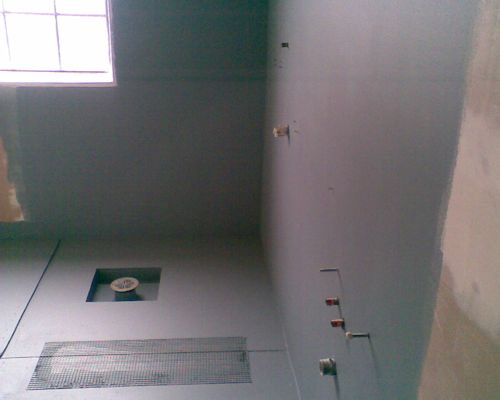 Audio for slide 82 (mp3)
Audio for slide 82 (mp3)
Moisture barriers, damp proof membranes (DPMs) and waterproofing membranes are terms that are often used interchangeably. Strictly speaking, however, the only true barriers that completely stop the transmission of moisture are metal (generally aluminium or copper) and glass. Nonetheless, AS 4858-2004 (Wet area membranes) defines a membrane as 'waterproof' if it achieves a specific performance level under test conditions. This level is called the 'moisture vapour transmission rate'.
 Audio for slide 83 (mp3)
Audio for slide 83 (mp3)
The types of moisture barriers that meet this definition include: Pre-formed sheet membranes that are either laid on top of the subfloor surface or bonded to the surface. Fibre reinforced liquid-applied membranes, which either contain chopped strands of fibre in the liquid, or have a separate sheet of mesh that's embedded into the liquid while it's being applied to the floor. Liquid-applied membranes that contain no reinforcement. Pre-formed sheet membranes are commonly found in the modular fibreglass units installed in bathrooms, such as shower trays and other fixtures.
 Audio for slide 84 (mp3)
Audio for slide 84 (mp3)
Liquid-applied membranes are used by floor tilers and vinyl floor layers working in wet areas. These areas include bathrooms, laundries, commercial kitchens and hospital rooms where water may be splashed around. They can also be used when there is a moisture problem coming from an external source. In these cases, their purpose is to resist any moisture that travels through the slab from getting to the surface and affecting the floor coverings or walls.
 Audio for slide 85 (mp3)
Audio for slide 85 (mp3)
In addition to these 'waterproofing' membranes, flooring installers sometimes use moisture suppressants if they want to begin an installation before green (freshly poured) concrete has dried to an acceptable level, or if there is low-level capillary movement of moisture through the slab.
 Audio for slide 86 (mp3)
Audio for slide 86 (mp3)
Types of liquid-applied membranes There are three main categories of liquid-applied membranes: Acrylic membranes are water-based and can be one or two part. One-part products are premixed, so they are applied direct from the container. Two-part systems normally contain a liquid polymer and a cement-based powder. Polyurethane membranes are 'reaction polymers' - that is, the molecules react with other chemicals to form strong cross-linked membranes. Epoxy membranes are all two-part systems that contain an epoxy resin and a reactive hardener. Some are designed to be flexible when cured, others are non-flexible.
 Audio for slide 87 (mp3)
Audio for slide 87 (mp3)
Joints and bond breakers The flexibility of a membrane is a major factor in its performance and the way it is installed. AS 4858 defines three classes of moisture membranes, based on their 'extensibility', or ability to stretch when there is movement in a crack or join. Class 1 membranes have low extensibility, so they don't 'extend' very well when there is movement in a crack or join in the floor, or between the floor and a wall.
 Audio for slide 88 (mp3)
Audio for slide 88 (mp3)
This means that if there is regular movement, the membrane might fatigue over time and eventually rupture. One solution is to put a foam backing rod where the floor and wall meet and cover it with a piece of bond breaker tape. When the moisture membrane is installed on top, the tape 'breaks the bond' over the joint and allows the membrane to flex and then return to normal. Note that if you're carrying out a resilient flooring installation, the backing rod should not protrude beyond a 90 degree angle.
 Audio for slide 89 (mp3)
Audio for slide 89 (mp3)
Class 2 membranes have medium extensibility. Because they're able to stretch more than Class 1 membranes, the width of the bond breaker tape can be proportionately less.
 Audio for slide 90 (mp3)
Audio for slide 90 (mp3)
Class 3 membranes have high extensibility. They are very flexible, so the bond breaker can be as little as a 12 mm bead of silicone. The different types of bond breakers used in residential construction are described in AS 3740-2010 (Waterproofing of domestic wet areas).
 Audio for slide 91 (mp3)
Audio for slide 91 (mp3)
Expansion joints are a different matter. These openings must be carried right through to the finished floor and fitted with an approved jointing system. We'll discuss this further in the next lesson.
 Audio for slide 93 (mp3)
Audio for slide 93 (mp3)
There's a wide range of moisture barrier products on the market and various installation techniques. Because moisture control is so crucial to the success of the overall floor covering project, you should always follow the manufacturer's instructions closely. This includes using any other products specified by the manufacturer if it forms part of an overall 'moisture barrier system', to ensure that all the products you're using are compatible and that you've satisfied their warranty conditions.
 Audio for slide 94 (mp3)
Audio for slide 94 (mp3)
Remember, incompatible solvent-based adhesives can react with some moisture barrier products and cause costly failures. Even if you've put a cement-based compound in between the adhesive and the moisture barrier, you may still not stop the solvent from penetrating. Below are the general principles involved in installing a two-part epoxy resin moisture barrier.
 Audio for slide 95 (mp3)
Audio for slide 95 (mp3)
Preparation and installation procedure
- Remove all surface contaminants and weak or powdery material from the concrete substrate. This can be done by shot blasting, scarifying or diamond grinding. The final surface must be clean, porous, bare concrete.
 Audio for slide 96 (mp3)
Audio for slide 96 (mp3)
- Remove all dust and debris. Allow the floor to stand for at least 30 hours to let any moisture from the shot blasting or grinding process dry out.
 Audio for slide 97 (mp3)
Audio for slide 97 (mp3)
- Note any cracks in the substrate for future reference. Check all expansion joints and construction joints and repair them as required.
- Give the floor a final vacuum to remove any remaining dust.
 Audio for slide 98 (mp3)
Audio for slide 98 (mp3)
- Apply a primer to the surfaces. This will improve the bond strength of the moisture membrane, particularly on fibre cement wall sheeting that has been sanded but is still holding a fine dust from the hard-set plaster.
 Audio for slide 99 (mp3)
Audio for slide 99 (mp3)
- Cover all joints, waste junctions and other penetrations with woven fabric tape, or other bond breaker materials, as specified by the manufacturer. In some cases, a silicone or polyurethane sealant may be recommended by the manufacturer.
 Audio for slide 100 (mp3)
Audio for slide 100 (mp3)
- Mix the epoxy and hardener components together. Apply the mixture to the floor with a notched trowel, squeegee or brush. Make sure that the correct thickness is maintained by using the specified amount for the area to be covered. Continue the barrier up the base of the walls to at least 150 mm above floor height.
 Audio for slide 101 (mp3)
Audio for slide 101 (mp3)
- Use a nap roller to roll out the product, making sure there are no pinholes or bubbles in the coating.
- Wait for the specified amount of time, and then apply a second coat at 90 degrees to the first coat. Again, check that the correct thickness is maintained by using the quantity specified for the second coat.
 Audio for slide 102 (mp3)
Audio for slide 102 (mp3)
Cracks and expansion joints Non-active cracks should be filled using the method recommended by the product manufacturer. One method is to 'V' gouge the crack, prime it with epoxy resin and then fill it with a slurry of epoxy resin and Portland cement. Active cracks - that is, cracks that could move over time and either open or close - should be noted and discussed with your supervisor to find out whether a structural engineer's advice is needed. These sorts of cracks can result in later moisture problems and show through a finished resilient floor, so they may require specialist treatment.
 Audio for slide 103 (mp3)
Audio for slide 103 (mp3)
Expansion joints must be continued right through the moisture membrane and underlayment. One method of keeping them open is as follows: put a backer rod in the joint and mark its position on the walls or other fixtures at each end coat over the top of the joint with the moisture barrier and underlayment put two vertical saw cuts through the underlayment to expose the joint remove the material and coat the sides of the saw cut with moisture barrier install a jointing system recommended by the manufacturer.
 Audio for slide 105 (mp3)
Audio for slide 105 (mp3)
Moisture suppressants are mostly used to 'fast track' a floor covering installation when the concrete is still green and has not yet reached an acceptable RH level. They're not designed to provide the same level of protection as a full moisture barrier. Most moisture suppressants are water-based products that can be applied with a roller, brush or sprayer. When a sprayer is used, several passes are applied until the area is evenly saturated. Then the excess material in the low spots is spread with a broom to the high spots.
 Audio for slide 106 (mp3)
Audio for slide 106 (mp3)
As the concrete pores fill up, any contaminants trapped inside the pores will tend to float to the surface. So the concrete needs to be sanded and vacuumed 24 hours after the suppressant is applied to remove the residual chemicals and substances. As with moisture barriers, you must carry expansion joints through to the finished floor height. These are typically filled with a jointing system made from polyurethane, silicone or epoxy resin.
 Audio for slide 109 (mp3)
Audio for slide 109 (mp3)
Levelling compounds are used to build up the underlayment that goes between a subfloor and the floor covering. They're generally used on concrete subfloors, but can also be applied to sheet flooring products and timber strip flooring.
 Audio for slide 110 (mp3)
Audio for slide 110 (mp3)
The process of installing an underlayment begins with priming and patching the subfloor to provide a suitable substrate for the levelling compound. Then the compound is poured onto the surface and smoothed and levelled. In this section, we'll look at the main types of products used to build up an underlayment and the general processes involved.
 Audio for slide 112 (mp3)
Audio for slide 112 (mp3)
Some people use the term 'levelling compound' to refer to the whole range of products used to patch, smooth and level a floor. But this general term can be subdivided into three more specific categories - smoothing, self-levelling and non-slump compounds.
 Audio for slide 113 (mp3)
Audio for slide 113 (mp3)
Smoothing compounds are thinly skimmed on the concrete surface as a top coat to take out fine defects in localised areas. Self levelling compounds are used to smooth and level an entire floor area. They are poured onto the floor and naturally form a level surface once they've been spread evenly. Non-slump compounds have more body, so they tend to stand up higher when placed on the floor. They are used for smoothing, creating 'falls' towards a floor waste, creating ramps up to a higher floor level, filling uneven areas of the floor, and repairing holes, cracks and defects.
 Audio for slide 114 (mp3)
Audio for slide 114 (mp3)
Finished thickness The amount of body or slump in the compounds can also be categorised in terms of the product's finished thickness on the floor. For example: Smoothing compounds are applied in one pass, in thicknesses ranging from a feather edge up to about 3 mm. Levelling compounds are applied in one pass but can often accommodate thicknesses of 10 mm or more. Bulk fillers are applied in one pass, typically in a layer that's at least 5 mm thick and sometimes up to 100 mm. Repair compounds are used for patching holes and compensating for large height differences, and can be built up in separate layers.
 Audio for slide 115 (mp3)
Audio for slide 115 (mp3)
When a levelling compound includes aggregate and is used as a bulk fill, it is often called a screed. This is the term that floor tilers use for the sand and cement mix that they put under tiles, especially in wet areas where there is a fall in the floor towards the waste pipe.
 Audio for slide 116 (mp3)
Audio for slide 116 (mp3)
Binding agents Different binding agents are used to give the levelling compounds particular characteristics, such as speed of curing and suitability for certain substrates and adhesives. Mineral compounds can be either cement based or calcium sulphate based. They are mixed with cold water to form a paste and then spread over the floor. For thicker layers, sand can be added as a filler.
 Audio for slide 117 (mp3)
Audio for slide 117 (mp3)
Dispersion compounds contain water-based synthetic resins, mineral fillers and other components. Most products are ready to use from the container, and don't need to be mixed with water. Reaction resin compounds are used for patching and grouting. Most formulations are based on polyurethane or epoxy resin and are supplied as two-part systems which are mixed together immediately before use.
 Audio for slide 119 (mp3)
Audio for slide 119 (mp3)
The purpose of a primer is to improve the adhesion of the levelling compound to the substrate. Sometimes they contain additives designed to address certain conditions in the subfloor - such as a sealant for very porous concrete to prevent air bubbles from rising up through the underlayment.
 Audio for slide 120 (mp3)
Audio for slide 120 (mp3)
However, it's important to note that primers are not designed to be moisture barriers, even if the product is described as a 'sealant'. Unless the product has been tested in accordance with AS 4858 and has satisfied the required 'moisture vapour transmission rate', you can't depend on it to stop rising damp or other moisture transmission problems. Nonetheless, some primers are designed to retard - or slow down - the movement of moisture, so they can help to protect adhesives and floor coverings from a small amount of moisture rising up through the slab.
 Audio for slide 121 (mp3)
Audio for slide 121 (mp3)
Underlayment manufacturers normally supply their own primers to go with their range of levelling compounds. They may also recommend other products for specific subfloor issues, such as dense or smooth substrates, or very absorbent surfaces. Most primers are water-based and can be applied with a roller, brush or spray gun. The general installation procedure for a water-based primer is set out below.
 Audio for slide 122 (mp3)
Audio for slide 122 (mp3)
Preparation and installation procedure Make sure that the surface to be primed is free from dust, dirt, oil, grease, curing compounds and any other contaminants. Check that the moisture content is appropriate for the primer being used and the underlayment that will be applied over the top. Pour the primer into a container, ready for application, if it is designed to be used undiluted.
 Audio for slide 123 (mp3)
Audio for slide 123 (mp3)
- Apply the primer to the floor using a roller, sponge or brush. Normally one coat is sufficient, but you may need two coats on very porous substrates.
- Allow the primer to fully dry before applying toppings or other products. This may take from 30 minutes to several hours, depending on the product, substrate surface and the weather conditions.
 Audio for slide 125 (mp3)
Audio for slide 125 (mp3)
Patching compounds are designed to fill holes, cracks, grooves and damaged areas that are too large for a self-levelling smoothing compound to fill efficiently. Hairline cracks are generally not a problem, but anything larger than about 5 mm should be filled with a patching compound.
 Audio for slide 126 (mp3)
Audio for slide 126 (mp3)
Some patching compounds are cement-based mortars and are applied with a putty knife or trowel. Others are made from epoxy or polyurethane, and can either be applied like a mortar or injected into the crack. You should never use gypsum-based products, like water putty or cornice cement. These products are high in alkali and can destroy adhesives, they swell when they get wet, and they don't have sufficient long-term adhesion to last the lifetime of the floor. Set out below is the general installation procedure for a typical cement-based patching compound.
 Audio for slide 127 (mp3)
Audio for slide 127 (mp3)
Preparation and installation procedure Make sure that the substrate is dry, firm and free from dust and any contaminants. Depending on the product and the type of substrate, you may need to prime the surface before applying the patching compound. Mix the powder with clean water in a mixing container to produce a mortar.
 Audio for slide 128 (mp3)
Audio for slide 128 (mp3)
- Apply the mortar with a trowel to the holes or damaged areas. Push the mortar into the void and leave it 'proud' (sitting slightly high) of the surface.
- After about 15 minutes, trim off the excess mortar and finish the surface with a wet trowel or sponge.
 Audio for slide 129 (mp3)
Audio for slide 129 (mp3)
- Leave the mortar to harden. Under normal conditions, this may take about one hour.
- Apply the smoothing and levelling compound before the mortar dries. Note that if the area is allowed to completely dry before the levelling compound is installed, you may need to re-prime the surface.
 Audio for slide 131 (mp3)
Audio for slide 131 (mp3)
Most self-levelling smoothing compounds are cement-based mixtures that are poured onto the floor and spread with a trowel or spreader. Some industrial compounds are water-based, latex-based or two-part epoxy resins. Each product has its own range of features and is designed for particular applications. The method of installation depends on the properties of the compound and the condition of the floor. Set out below is the general installation procedure for a typical cement-based underlayment.
 Audio for slide 132 (mp3)
Audio for slide 132 (mp3)
Preparation and installation procedure Make sure that the subfloor surface meets the required standards. This includes checking that the moisture content and pH levels are suitable and that the surface is clean and properly prepared. Apply the primer specified by the manufacturer, using a sprayer, roller or brush. Wait the required amount of time for the primer to cure.
 Audio for slide 133 (mp3)
Audio for slide 133 (mp3)
- Set up the area where you will mix the levelling compound. Make sure there is good ventilation and lighting. Cover the floor of the mixing area with plastic sheeting to make the clean-up process easier.
- Mix the levelling compound in a bucket using an electric drill and mixing paddle. Measure the proportions of water and compound accurately, according to the manufacturer's instructions, using measuring buckets.
 Audio for slide 134 (mp3)
Audio for slide 134 (mp3)
- Apply the levelling compound to the floor. Depending on the product and the thickness, you may need to use a steel trowel and/or a thickness spreader. Most underlayments can be installed from a true 'feather edge' up to 6 mm thick. For thicker application, some manufacturers specify aggregate as a filler.
 Audio for slide 135 (mp3)
Audio for slide 135 (mp3)
- Check the surface finish and floor levels to make sure that they're within the required standards.
- Clean up the work area and all tools and equipment. Store the unused levelling compound in resealed plastic bags or containers.
 Audio for slide 136 (mp3)
Audio for slide 136 (mp3)
Working to standards We talked about standards in the unit: Inspecting and testing subfloors. You'll recall that the purpose of a 'standard' is to set the benchmark for what's considered an acceptable job. This not only gives you a specific level of performance to work to, it also means that you have a basic standard that you can agree on with the client if there is ever a dispute about the quality of your work.
 Audio for slide 137 (mp3)
Audio for slide 137 (mp3)
The Australian Standards that specify the tolerances allowed in the 'planeness' and 'smoothness' of a subfloor surface are: AS 2455-2007: Textile floor coverings - Installation practice AS 1884-2012: Floor coverings - Resilient sheet and tiles - Installation practices. The tolerances set out in AS 1884-2012 are as follows.
 Audio for slide 138 (mp3)
Audio for slide 138 (mp3)
Planeness: When a 2 metre long straightedge is placed on a concrete floor, resting on two points that are 2 metres apart, the maximum deviation from planeness (or 'flatness') is 4 mm. Smoothness: When a 150 mm long straightedge is placed on a concrete floor, resting on two points, the maximum deviation is 1 mm.
 Audio for slide 140 (mp3)
Audio for slide 140 (mp3)
We looked at the basic principles of estimating primer and underlayment quantities in the unit: Planning and costing. You'll recall that the simple formula for working out the amount of primer needed to cover a floor is: Area of floor ÷ coverage of product = volume required The units of measure that these figures are generally expressed in are: Area of floor - square metres (m2) Coverage of product - square metres per litre (m2/L) Volume required - litres (L)
 Audio for slide 141 (mp3)
Audio for slide 141 (mp3)
The same principle is used for working out underlayment quantities. However, this time the coverage is generally shown in square metres per bag or kilogram at a given thickness (m2/bag or m2/kg at whatever thickness the manufacturer nominates). This means that if your finished thickness is going to be different from the manufacturer's nominated thickness, you'll need to make an adjustment to the quantity.
 Audio for slide 142 (mp3)
Audio for slide 142 (mp3)
For example, say you were going to spread a levelling compound at an average thickness of 3 mm on the subfloor, and the coverage rate printed on the bag reads: Coverage: 13 m2/bag at 1 mm thick To work out the total quantity of compound required, you would need to use the same formula and multiply your answer by 3.
 Audio for slide 143 (mp3)
Audio for slide 143 (mp3)
If you need to revise these basic principles before we move on to some more complex examples, go to the following lessons in Planning and costing: Primers and adhesives Levelling compounds. You may also want to revise the maths basics that underlie these calculations in the unit: Making measurements.
 Audio for slide 144 (mp3)
Audio for slide 144 (mp3)
Ramps In geometric terms, ramps are actually triangular prisms. That is, they are a normal square or rectangular shape on top, but their depth is triangular. Let's say you needed to build a ramp between two rooms to accommodate a floor height difference of 20 mm. You have chosen a slump-free repair mortar with a coverage rate that reads: Coverage: 12 m2 at 1 mm thick (per 20 kg bag) The steps involved in working out the quantity are as follows. Remember that we have to convert all measurements from millimetres to metres for these calculations.
 Audio for slide 146 (mp3)
Audio for slide 146 (mp3)
2. Find the coverage for the given thickness The nominated coverage is 12 m2 per 20 kg bag when spread at an average thickness of 1 mm. So if the ramp was only 1 mm thick, you would need: 1.8 m2 ÷ 12 = 0.15 bags
 Audio for slide 147 (mp3)
Audio for slide 147 (mp3)
3. Find the total number of bags In our case, the ramp thickness goes from 0 mm at one end to 20 mm at the other. So the average thickness is 10 mm. In other words: Average thickness = thickness at start + thickness at end ÷ 2 = 0 + 20 ÷ 2 = 10 mm This means we need to multiply the Step 2 figure by 10: 0.15 x 10 = 1.5 bags
 Audio for slide 148 (mp3)
Audio for slide 148 (mp3)
Diluted primer Some primers are diluted with water when the substrate surface is very porous. Let's say that you have diamond ground the concrete subfloor shown in this diagram and are about to coat it with primer.
 Audio for slide 149 (mp3)
Audio for slide 149 (mp3)
The container says that the coverage rate is 3.5 m2/L, but that for porous concrete the primer should be diluted with water at a 2:1 ratio. This means that 2 parts water will be added to every 1 part primer. In other words, if there was a total of 3 litres required for the floor, 2 litres would be water and 1 litre would be primer. How much water and primer will you need for this job?
 Audio for slide 151 (mp3)
Audio for slide 151 (mp3)
Step 2: Find the total volume at the normal coverage rate Volume (L) = area (m2) ÷ coverage (m2/L) = 21.7 m2 ÷ 3.5 = 6.2 litres
 Audio for slide 152 (mp3)
Audio for slide 152 (mp3)
Step 3: Find the water and primer volumes A water/primer ratio of 2:1 means: 2 parts water + 1 part primer = 3 parts in total. So:
You can check your answer by adding the two components together: 4.1 litres water + 2.1 litres primer = 6.2 litres in total
| Volume of water | = total volume ÷ total no. of parts x no. of parts water |
| = 6.2 litres ÷ 3 parts (in total) x 2 parts (water) | |
| = 4.1 litres | |
| Volume of primer | = 6.2 litres ÷ 3 parts (in total) x 1 part (primer) |
| = 2.1 litres |
 Audio for slide 153 (mp3)
Audio for slide 153 (mp3)
Wastage factors Depending on the type of job and the products you're using, you may want to build a wastage factor into your calculations. This helps to compensate for slight variations in estimates or small amounts of wastage. Installers often allow for 5 to 10% wastage on primers and levelling compounds. For example, if you wanted to add 10% wastage to the primer calculation above, the total volume required would be: 6.2 litres + 10% (0.62 litres) = 6.8 litres If you need more practise on using percentages, go to the 'Decimals and percentages' lesson in Making measurements.







